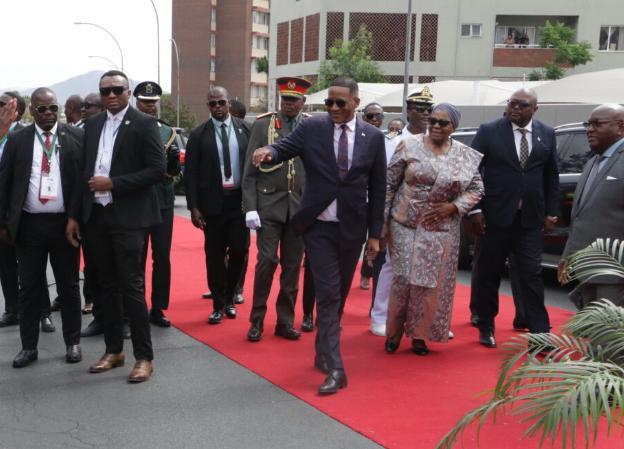Africa-Press – Namibia. Botswana founding president Sir Seretse Khama’s legacy was engraved in the Namibian capital after a prominent street in the city was renamed after him.
The move not only paid tribute to one of Africa’s foremost leader, but also symbolised the strong ties the two counties enjoy.
The street, located in Windhoek’s Ausspannplatz area and streches to the east of Windhoek, was formely known as Feld Street.
The event brought together President Netumbo Nandi-Ndaitwah, Botswana’s President Duma Boko, former president Seretse Ian Khama, amongst others, in a jovial and free-spirited showing.
President Boko, with characteristic humour and great oratory skills, joked that the rain was a celebration in itself.He said he is proud to have brought it to the occasion, drawing smiles and applause from the crowd.
Also present was Chief Tjinaani Maharero of the Maharero Royal House Traditional Authority.
It was Maharero, under the banner of the traditional authority, who spearheaded the renaming of the street after proposing it to the City of Windhoek.
His role in facilitating the renaming ceremony earned him praise from the visiting Botswana president, who described him as a close kin.
Maharero’s forefather hails from Duma’s native Mahalapye village in northern Botswana.
In fact, some of them are interred there, Boko said.
President Nandi-Ndaitwah used the occasion to highlight Botswana’s crucial role in Namibia’s liberation struggle.
“Namibia cherishes the memories of Sir Seretse Khama. Many of our leaders and compatriots passed through Botswana during exile, seeking freedom and independence. His unwavering support for self-determination and his solidarity against colonial oppression remain engraved in our national memory,” she said.
The Namibian President framed the street renaming as more than symbolic.
“As a street connects people and places, so does the legacy of Seretse Khama connect generations. This is a reminder that leadership, grounded in humanity, can transform nations. Today, we honour those values and commit to following in the footsteps of these giants in our region and on the continent,” she said.
Duma Boko added a personal and historical perspective, reflecting on the intertwined heritage of the two countries.
Drawing on his family roots and childhood experiences, Boko emphasised the depth of connection between Namibians and Batswana, tracing it across culture, geography and history.
“The ties that bind us run deeper than politics. Today, as we name a street after Sir Seretse Khama, we celebrate friendship, shared values and the profound unity of our peoples,” he said.
Boko recalled how cross-border social life shaped generations, including festive gatherings and cultural exchanges that brought Namibians and Batswana together long before independence.
His reflections underscored that the street renaming is a recognition of shared history as much as it is a tribute to a single leader.
Former president Ian Khama, son of Sir Seretse Khama, paid tribute to his father’s enduring ideals, stressing leadership as service rather than privilege.
“This street is more than a name upon a signpost. It is a symbol of the values my father championed: justice, dignity, unity and the African spirit of self-determination. He believed that progress comes through partnership and mutual respect, not domination or fear,” he said thankfully.
Khama reflected on the geographic and historical connections between Botswana and Namibia.
“When my father looked west toward Namibia, he saw not just a neighbour, but brothers and sisters. Our futures, like our rivers and deserts, flow together. Today, this street bears his name as a lasting reminder of friendship, cooperation and shared destiny,” he said.
Seretse Khama served as the first president of Botswana, a post he held from 1966 to his death in 1980.
Khama led his country’s liberation movement and the transition from British rule to an independent nation.
He founded the Botswana Democratic Party in 1962.
In 1966, Botswana gained independence and Khama was elected as its first president.
During his presidency, the country underwent rapid economic and social progress.
Khama served as president until his death in 1980, and was succeeded in office by Ketumile Quett Masire.
His son, Seretse Ian Khama, served as Botswana’s fourth president from 2008 to 2018
The renamed street joins with that named after another African great, Tanzania’s founding president Julius Nyerere.
This, the speakers said, symbolically linked the two African leaders who championed unity, democracy and independence for their respective republics.
The event comes ahead of a bi-national commission scheduled for this week, emphasising continued collaboration in governance, economic development and regional integration.
As the ribbon was cut and the new street sign unveiled, the presence of ministers, civil servants and local authority leaders lent weight to the ceremony, marking it a historic milestone in bilateral relations.
The ceremony, attended by ministers, civil servants and representatives of the Maharero Royal House, featured cultural performances and was briefly interrupted by gentle rainfall – a symbolic blessing, according to many attendees.
For More News And Analysis About Namibia Follow Africa-Press






